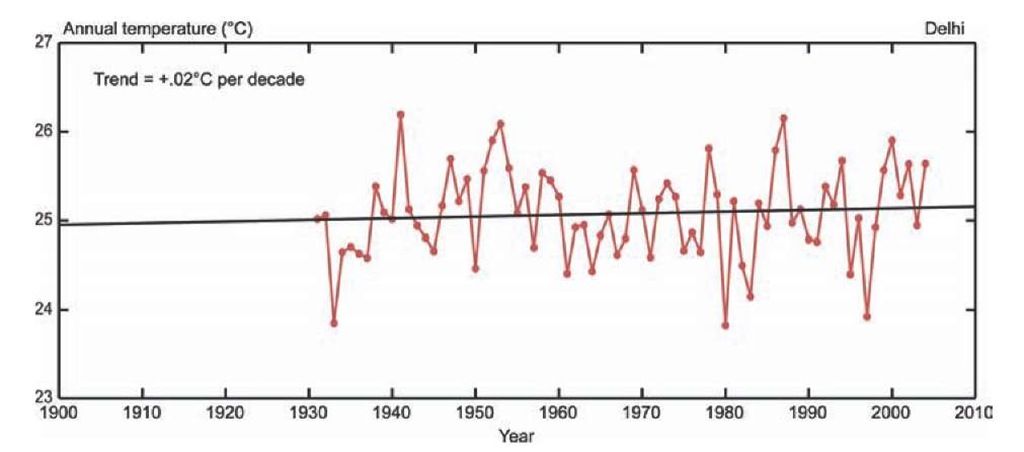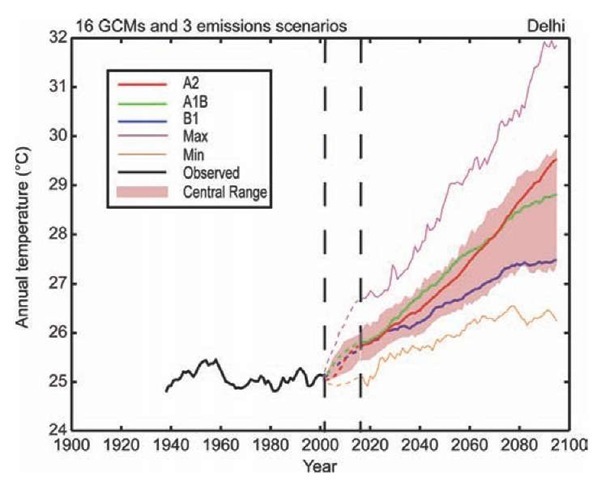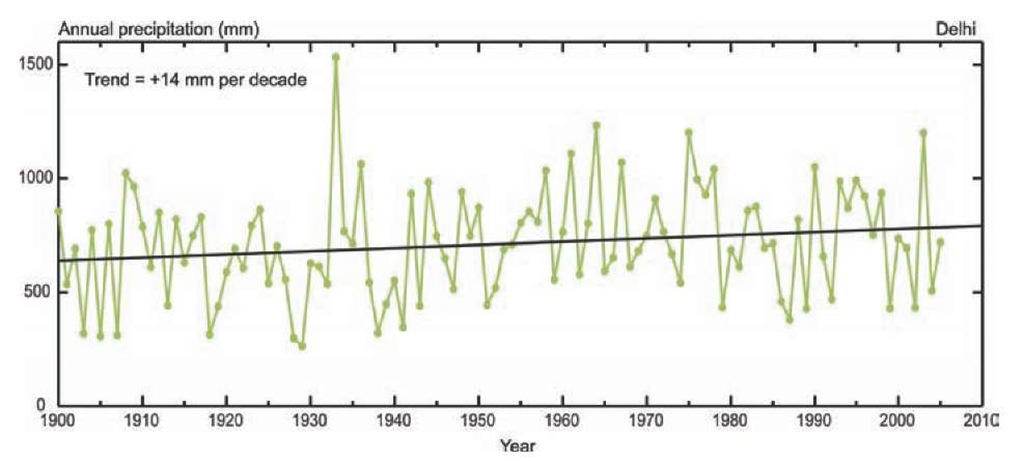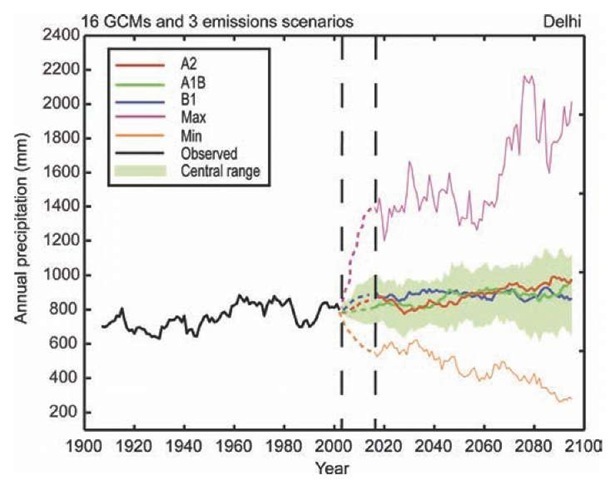Delhi, India
Metropolitan Delhi has a population of 16 million, and is rapidly urbanizing with a 3.85 percent annual growth rate over the 1990s amounting to half a million additional inhabitants each year. In 1901 Delhi had 400,000 inhabitants. Furthermore, rising per capita incomes are increasing energy consumption and over-stretching its infrastructure. Delhi is a city of wide income contrasts – in 2000, 1.15 million people were living below the National Poverty line. On the other hand, Delhi’s Gross State Domestic Product at current prices was about US$27 billion during 2007 (Department of Planning, 2008).
Delhi has three distinct seasons - summer, winter, and monsoons with extreme temperatures and concentrated precipitation. Summers begin in mid March, lasting for three months, and are dry and hot with temperatures peaking at about 40 °C in the months of May and June. Monsoons are between mid June and September, during which period Delhi receives most of its 600 millimeters of annual rainfall, with July and August getting as much as 225 millimeters each, see Figures 2.7-2.10 for seasonal variation in temperature and precipitation. Winters are dry and last from November to mid March, with December and January being the coldest months with temperatures as low as 7 °C (Delhi, 2009).
Hazards and vulnerability
The National Action Plan for Climate Change and related analysis provides an overview of climate change issues confronting India as recognized by the federal government (see Government of India, 2002, 2008). Through a review of research on climate science, policy papers, and practitioner notes, five hazards are identified (Revi, 2007).
Figure 2.7: Observed temperatures, Delhi.
First, although there are uncertainties with scaling down global models such that they reflect regional climate conditions such as the Indian monsoon, temperature, precipitation, and sea-level are likely to rise. For a summary of observed and projected temperatures for Delhi see Figures 2.7 and 2.8. Mean extreme temperatures, as well as maxima and minima, are expected to increase by 2 to 4 °C, likely to result in an average surface warming of 3.5 to 5 °C within this century.
Second, average mean rainfall is projected to increase by 7 to 20 percent due to the increase in mean temperature and its impact on the Indian monsoon cycles within the latter half of this century (see Figures 2.9 and 2.10). However, some drought-prone areas are expected to become drier and flood-prone areas will very likely experience more intense periods of precipitation. Third, 0.8 meters is the projected centennial rise in mean sea level. Fourth, extreme events like the Mumbai flood of 2005 are expected to be more frequent in western and central India. A combination of these hazards exposes the cities in this region to a range of other climate-induced extreme events such as droughts, temporary and permanent flooding, both inland and in coastal areas, and cyclones.
Figure 2.8: Projected temperatures, New York City.
Delhi’s physical infrastructure, social services, and slum populations make the city highly vulnerable. Demand for basic infrastructure services such as water, electricity, and public transport far exceeds supply (Delhi Development Authority, 2005). To add to the existing conditions, climate change-induced variability in rains could worsen the severe shortage of drinking water in summers and aggravate the floods in the monsoon season, thus making the existing energy shortage more challenging to address. With regard to transportation, Delhi has the highest per capita vehicular population in India – 5.4 million automobiles for 15 million people. This poses a challenge for a city with mixed land use and varying urban densities within the metropolitan region to introduce effective modes of public transport. Carbon emissions from vehicles, traffic congestion, and increasing particulate matter all pose challenges. These and other challenges create widespread public health risks to the inhabitants of Delhi. For example, lack of adequate sanitation facilities for the poor poses a problem for a rapidly growing city where a large proportion of the population lives in slums.
The hyper-dense nature of the slums, despite Delhi’s relatively low population density and the centrality of the poor in provision of services – from household help to a range of labor-intensive and low-wage tasks – poses an enormous challenge. About 45 percent of the city’s population live in a combination of unregulated settlements, including unauthorized colonies, villages, and slums. Further, three million people live along the Yamuna River, which is prone to flooding, where 600,000 dwellings are classified as slums.
Moreover, increasing competition for scarce basic services caused by the rapidly growing population of Delhi poses public health as well as quality-of-life challenges. For example, some poor settlements lack basic amenities resulting in open defecation. Although the extent of the impacts remains to be assessed, potential climate change impacts added to current local environmental stresses are likely to intensify this crisis. Moreover, the low quality of housing in slums and their proximity to environmentally degraded land and flood-prone areas further exacerbate the vulnerability of the poor. Within the slums, climate-induced stress is likely to affect certain social groups more than others, particularly the elderly, women, and children.
Figure 2.9: Observed precipitation, Delhi.
Adaptive capacity: current and emerging issues
The government of Delhi has made many efforts towards climate change mitigation, but there is less emphasis on adaptation. In addition to the issues of energy, water, and transportation, mitigation projects also encompass public health and other social and economic development efforts. Climate change mitigation efforts by the government of Delhi were introduced first in the government departments and are being gradually expanded to include other stakeholders – schools, households, and firms. Most initiatives remain project-oriented (Department of Environment, 2008).
Some projects, such as the Bhagidari program, seek participation from neighborhood groups, private-sector associations, schools, and non-governmental organizations to enhance civil society engagement in environmental management, creating an expanded policy space for addressing climate change. Such collaboration holds the potential to address broader issues of climate adaptation by building awareness as well as capacity of stakeholders to respond.
Figure 2.10: Projected precipitation, New York City.
However, the most striking of all climate mitigation initiatives in Delhi so far is the establishment of the world’s largest fleet of compressed natural gas (CNG) fueled public transport in response to a Supreme Court order. This has resulted in 130,000 CNG-powered vehicles, 145 CNG fuel stations, as well as improved vehicular emission standards like those adopted by the European Union. The greatest lesson from this initiative is in recognizing the diverse set of triggers and actors that can start adaptation and mitigation programs.
Some mitigation measures have co-benefits for adaptation. For instance, adoption of green building technology that is mandatory for the Public Works Department and the Airport Authority was introduced to address mitigation, but has adaptation benefits as well. Expected greenhouse gas emissions reductions are 35 to 50 percent in general energy consumption and up to 100 percent in energy for water heating. Moreover, the New Delhi Municipal Council aims to reduce other demand for energy and has set time-bound efficiency targets. The Municipal Corporation of Delhi is making efforts to install compact fluorescent lamps and capacitor banks to increase energy efficiency. Further, the government has a program that subsidizes electric vehicles and is encouraging the introduction of the Reva car, as well as battery-operated two- and three-wheelers.
Delhi also has expanded its forest cover over the past ten years. The cities greening program is considered to be one of the largest in the world. The forest cover has grown from 3 percent in 1998 to 19 percent in 2005. The city planted 1.7 million trees in 2007 and the forest cover grew to 300 square kilometers. To maintain the momentum, the city planned to plant 1.8 million saplings in the fiscal year 2009, increasing the greenery cover to a total of 326 square kilometers. The city also has a policy to plant ten trees for every tree chopped down. This project is done in collaboration with several stakeholders including school children, female homemakers, and neighborhood associations. The saplings are distributed gratis through a host of distributors. This afforestation effort is part of a Clean Development Mechanism (CDM) project proposal. To scale up mitigation efforts, the Delhi government has established a program with the aim to raise awareness about carbon credits and clean development mechanisms among various departments. The objective is to develop a holistic approach towards reducing greenhouse gas emissions and enable projects that can redeem carbon credits. In essence, these mitigation projects can prove vital for adaptive capacity as well. For example, green roofs and walls, and tree planting help to cool the urban environment and reduce heat island effects, as do many of the energy-efficiency projects related to buildings.
While the neglect of adaptation remains a concern, another co-benefit to mitigation efforts in Delhi is the climate change awareness and administrative capacity being built as a result of mitigation projects that may help as adaptation projects and policy measures are introduced. Not only is the government developing financial incentives to introduce programs and adopting a multisectoral approach that involves various departments within the city jusrisdiction, they are also learning to utilize mechanisms such as UNFCCC’s CDM funds that are likely be equally relevant for adaptation. Illustrations of such efforts are the CDM projects and certified emission reductions (CERs) in the water sector.
While Delhi is making major efforts towards mitigation of climate change through carbon emission reductions and other environmental improvements, there is a significant lack of awareness about the need for adaptation to climate change. Therefore, the city has not yet planned for adaptation. Further, Delhi’s response to climate change is often less than effective as well as piecemeal because its efforts are primarily project-oriented. In the experience of the Delhi government, incentives – subsidies and grants – have been effective for initiating projects, but operation and management frequently remain neglected. For instance, subsidies to install rainwater-harvesting systems have created demand, but subsequent maintenance is too often ignored and many systems fall into disrepair. Such experiences hold the potential to inform adaptation efforts as well.
Gradually the city is developing a programmatic approach, but there is a need to coordinate between departments and among levels of government. For example, while the Prime Minister of India has recently released the National Action Plan for Climate Change, Delhi’s local efforts will need to be reconciled with regional and national priorities.
Lagos, Nigeria
Lagos is Africa’s second most populous city and has grown explosively, from 300,000 in 1950 to an expected 18 million by 2010, ranking it as one of the world’s ten largest cities. The metropolitan area, an estimated 1,000 square kilometers, is a group of islands surrounded by creeks and lagoons and bordered by the Atlantic Ocean. Lagos is the commercial and industrial hub of Nigeria, a country with a GDP three times larger than any other country in West Africa. Lagos is home to a large amount of commercial infrastructure, and has greatly benefited from Nigeria’s natural resources of oil, natural gas, coal, fuel wood, and water. For an overview of the state of Nigerian cities see UN-HABITAT (2004).
The climate of Lagos is affected by Atlantic Ocean and atmospheric interactions both within and outside its environment, in which the Inter-Tropical Convergence Zone (ITCZ) plays a controlling factor. The movement of the ITCZ is associated with the warm humid maritime tropical air mass with its southwestern winds and the hot and dry continental air mass with its dry northeasterly winds. Maximum temperatures recorded during the dry season are high and range from 28 to 33 °C when the region is dominated by the dry northeast trade winds. Minimum temperature of about 26 °C is experienced during the wet season of May to September.
The city of Lagos experiences relatively high to very high temperatures throughout the year. The mean annual temperature is about 28 °C and the maximum and minimum temperatures are 33 °C and 26 °C respectively. High to very high monthly rainfall is also experienced between May and November, although significant variations in monthly rainfall peak values are experienced. For example, between 1950 and 2006, more than ten instances were recorded with a maximum rainfall of over 700 millimeters. Minimum monthly rainfall of less than 50 millimeters is experienced between December and March. Occasionally, extreme precipitation events are experienced in June. On June 17, 2004, for example, 243 millimeters of rain was experienced in Victoria Island and the Lagos environs. This resulted in flooding of streets and homes, collapse of bridges, and massive erosion of the main road linking Lekki to Lagos Island. About 78 percent of the total rainfall amount for the month was experienced in one day in June. The city was ill-prepared for that amount of rainfall.




